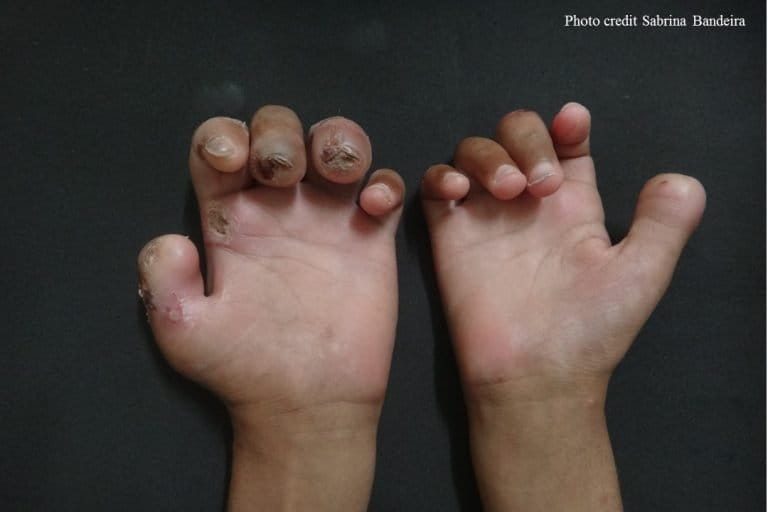- Researchers have found a high prevalence of leprosy among nine-banded armadillos in Brazil’s western state of Pará.
- They also surveyed 146 people in the region and found that people who ate armadillos more than once a month showed higher signs of exposure to leprosy infection compared to people who consumed armadillos less frequently or not at all.
- Overall, the study found that frequently handling armadillos, such as hunting or cleaning or cooking armadillo meat, puts people at higher risk of getting infected with leprosy.
Armadillos are a popular bushmeat in the Brazilian Amazon, but handling and eating these scaly mammals could put humans at risk of leprosy, a new study published in PLOS Neglected Tropical Diseases has found.
Humans usually contract leprosy, also known as Hansen’s disease and caused by the Mycobacterium leprae bacterium, from other infected people when they cough or sneeze, spreading aerosols containing the bacteria. Most people have a natural immunity against leprosy, but in some people the infection progresses to disease, causing skin lesions, nerve damage and bone loss.
There’s another potential source of leprosy infection: nine-banded armadillos (Dasypus novemcinctus). These animals are among the few wild species known to harbor the leprosy bacteria, and have been shown to be responsible for some human leprosy cases in the southern United States.
Leprosy in the U.S., however, remains very rare — around 200 new cases every year — and the chances of contracting leprosy from an armadillo are extremely low.
Brazil, by contrast, sees more than 25,000 new human leprosy cases every year. Local communities in Brazil’s Amazon region also interact with armadillos more than elsewhere, hunting, cooking and eating the animals regularly.
To see whether leprosy is prevalent among armadillos in the Amazon, a team of researchers tested liver and spleen tissues from 16 nine-banded armadillos in Brazil’s western state of Pará. Ten of these animals, or 62 percent, showed signs of leprosy infection — an infection rate more than three times higher than what previous research has found among armadillos in the southern U.S.
The researchers also surveyed 146 people from two villages in Pará, and found that 65 percent of them had some kind of regular interaction with armadillos, either through hunting, cleaning the animals and preparing them for cooking, or by eating them.

When the team compared all the people who ate or handled armadillos with those who did not, they found no difference between their leprosy exposure levels.
However, they observed that a subset of people were at a higher risk. People who ate armadillos more than once a month — in some cases even twice a week — showed higher signs of exposure to leprosy infection compared to people who consumed armadillos less frequently or not at all.
Most of the individuals who liked eating armadillos a lot were hunters, John Spencer, an associate professor at Colorado State University, U.S., and co-author of the study, told Mongabay.
“Some of them also cleaned the meat, removing parts of the animal that are not edible, and in the process getting exposed to blood and other bodily fluids inside the animal. Some of them were involved in cooking the meat, while some participated in all of these activities,” Spencer said. “So this particular group that really liked to eat armadillos seemed to have a lot more risk factors, and this might be the reason that the antibody levels” — the proteins that respond to pathogens — “in this group are so much higher.”
Richard Truman, former chief of research for the National Hansen’s Disease Program in Louisiana, U.S., who has studied leprosy in armadillos extensively and was not involved in Spencer’s study, said: “What this study has done different than other studies in South America was to detect the infection of armadillos by multiple methods … then show that people who have increased interactions with armadillos also have increased risk for leprosy.”
However, Truman cautioned that 16 armadillos was a small sample size, and the animals were not collected systematically. “So the percent positives is not very meaningful at this time,” he said.
Spencer, though, said he felt the sample size was large enough to make the conclusions they did. Getting armadillo samples was a huge logistical challenge, he added. The researchers needed fresh tissues samples for their analysis, which meant they had to rely on recently hunted armadillos. Killing wild armadillos for consumption is, however, prohibited in Brazil, and only some hunters were willing to help them out.
“If the animal was killed sometime between midnight and 5 a.m., they would call us and we would get to the location and sample the liver and spleen before things started to decay, because then it’s difficult to look for DNA markers from the bacteria,” Spencer said.

From humans to armadillos to humans
Armadillos were not always associated with leprosy.
The armored animals are native to the Americas, and the New World did not have leprosy until European explorers arrived — which means that armadillos acquired leprosy from humans some time in the last 400 to 500 years. Since then, the animals have become a source of infection themselves.
In 2011, Truman published a paper showing a match between the DNA sequence of M. leprae strains among infected people and armadillos in the southern U.S., providing a definitive link between the two.
“If you’ve never come in contact with an untreated leprosy patient, and you come down with leprosy, the chances are very likely that you picked it up somehow from some environmental source like armadillos,” Spencer said. “The difficulty in Brazil is that they have so much leprosy there.”
Brazil has a leprosy incidence rate of 1.2 cases per 10,000 people, or more than 25,000 new cases out of a population of 207 million. It’s the only country in the world with more than 1 new case per 10,000 population.
“That means that there’s an awful lot circulating and a lot of it is human to human,” Spencer said. “However, if you interact with armadillos and you do it in ways that are quite frequent, then that will generally increase your risk of coming down with leprosy from that source.”

Armadillo liver-and-onion ceviche
The leprosy bacteria affects humans and armadillos slightly differently.
In humans, the bacteria limits itself to the skin and nerves and is usually not fatal, Spencer said. The bacteria prefers human skin because it is a few degrees cooler than the internal organs. “The internal body temperature, 37 degrees Celsius [98.6 degrees Fahrenheit], is too hot and lethal for the bacteria,” he added.
The armadillo body, by contrast, including internal organs like the liver and spleen, has a temperature of around 34 degrees Celsius (93.2 degrees Fahrenheit), making it an ideal growing environment for the bacteria. Not only does this make the disease fatal for armadillos, it provides yet another risk of exposure for people who kill, skin or handle armadillo meat for consumption.
For example, in certain areas in Pará, some people consume raw armadillo liver in the form of a liver-and-onion ceviche. Since the liver is one of the main organs where the growth of the leprosy bacteria is highest, eating raw liver could indicate a high-risk behavior, the authors write — one that could lead to infection.
The link between armadillo and human leprosy infections in the Brazilian Amazon, however, still needs further investigation, experts say.
Juliano Vilaverde Schmitt of São Paulo State University, Botucatu, School of Medicine, said that while the study was interesting, the connection between the high prevalence of leprosy infection in armadillos and the higher prevalence of human leprosy cases in the region was not very robust.
Truman agreed that more research was needed.
“The next step for these investigators is to perform systematic studies to describe the actual prevalence of the infection in the armadillos, the robust nature of the disease, and to link the presence of disease in the armadillos with humans through identifying the strain-types that are shared and manifest by armadillos and humans in the region,” he said.

Citation:
da Silva MB, Portela JM, Li W, Jackson M, Gonzalez-Juarrero M, Hidalgo AS, et al. (2018) Evidence of zoonotic leprosy in Pará, Brazilian Amazon, and risks associated with human contact or consumption of armadillos. PLoS Negl Trop Dis 12(6): e0006532. https://doi.org/10.1371/journal.pntd.0006532